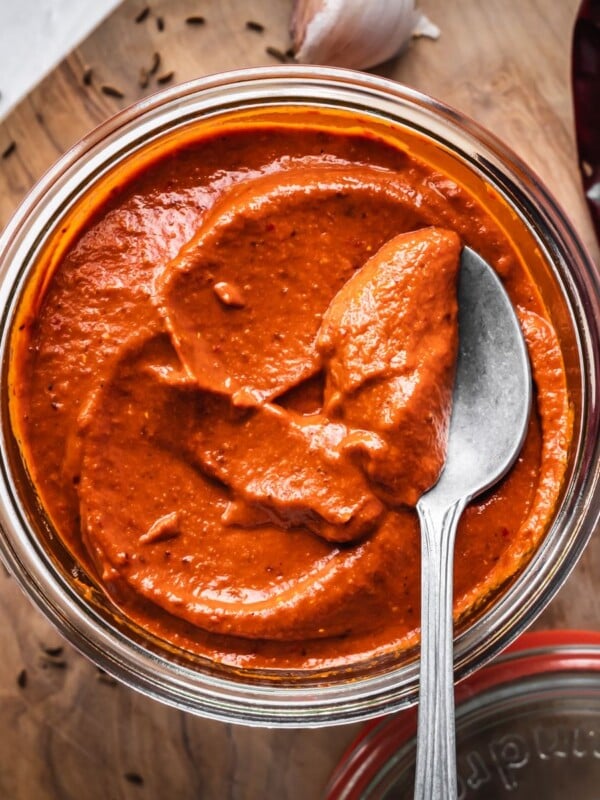Is it a salad? Or Is it a condiment? Turkish Ezme is a perfectly sweet, tangy, spicy and salty condiment that can be enjoyed as a dip, as a garnish on kebabs and grilled meats, or as a side dish. The recipe is quite customizable to suit your spice level.
If you’re looking for other sides and dips, try my Turkish Cacik (cucumber yogurt dip), Mutabal (roasted eggplant dip), and Muhammara (walnut and red pepper dip).

Table of Contents
What is Ezme?
Turkish Ezme (acılı ezme) is a traditional spicy, tangy tomato and pepper relish, condiment or finely chopped salad that’s often served as part of a mezze platter or an appetizer in Turkish restaurants and homes. “Ezme” means “mashed” or “pureed” in Turkish, which reflects its texture.
It is also used as a condiment on kebabs, like Adana Kebab or even doner wraps. But you can also serve it with other kebab recipes like my Beef Kofta, Chicken Kafta, Koobideh Kabob and even Chicken Shish Tawook.
The main ingredients include finely chopped tomatoes, peppers, onions, garlic cloves, parsley, and chili peppers, dressed with olive oil, lemon juice, and pomegranate molasses for a balanced flavor profile. You can make it as spicy or as mild as you like. It’s almost like a Turkish salsa.
Serve it with Turkish pide bread, warm Lebanese pita bread, or pita chips.
Ingredients
This easy recipe uses pretty simple and common ingredients. There’s nothing fancy here, apart from the pomegranate molasses, sumac and Aleppo pepper. Let’s get into it.

- Fresh Tomatoes: Use a paste-type tomato like a Roma or San Marzano. These tomatoes are very fleshy and have very low water content. If you must use regular vine or beefsteak tomatoes, I recommend cutting out the seeds to reduce the water content.
- Bell Pepper: I am using a red bell pepper here, but you can certainly use green bell peppers or a combination of red or green.
- Pomegranate Molasses: A staple in every Middle Eastern, North African, and Levantine kitchen. You can find bottled pomegranate molasses at most grocery stores (check the world foods aisle). Try some of my other recipes that feature this sweet and tangy ingredient: Mint Chimichurri, Fattoush Salad, and Beef Sambousek.
- Aleppo Pepper Flakes: This is an important ingredient for Levantine Cuisine as well as Turkish cuisine. The Aleppo Pepper comes from Aleppo Syria, and goes by a few other names like Pul Biber and Halaby Pepper. It used to be difficult to find this chili flake, but it’s much easier now. You can find it at all Middle Eastern grocery stores and online. You can substitute with regular red pepper flakes too.
- Sumac: Another important Middle Eastern spice. It’s also available at Middle Eastern grocers and even a well-stocked standard grocery store. I have many recipes that feature sumac like Musakhan (Palestinian Sumac Chicken), Sumac Onions and Muhammara (red pepper dip).
See the recipe card for full information on ingredients and quantities.
How to Prepare Turkish Ezme Salad
This recipe is quite straightforward to make. I strongly recommend that you hand chop the ingredients, which can take some time and good knife skills. But if you are pressed for time, feel free to use a food processor. I will outline some tips on that in the Expert Tips section below.

Step 1. Make dressing. Directly in your serving bowl or in a large bowl, combine the extra virgin olive oil, lemon juice, pomegranate molasses, tomato paste, chili flakes, sumac, a big pinch of salt, and fresh cracked black pepper.

Step 2. Chop. If your tomatoes are really juicy, consider removing the seeds as they will add too much liquid to the salad. Very finely chop the tomatoes, red pepper, onion, parsley and garlic into tiny pieces.

Step 3. Mix the salad. Add the chopped vegetables to the salad dressing bowl and combine.

Step 4. Season and serve. Taste the salad and adjust the seasoning. You may need more salt and maybe more lemon juice depending on your preference.
Expert Tips
- Remove the tomato seeds. The seed cavities in juicy tomatoes can add too much moisture to your salad. Cut them out and discard them before chopping.
- Strain the fresh vegetables. If you still feel like the vegetables are very wet after chopping, you can transfer them to a fine mesh sieve and let them drain for a few minutes before proceeding with the recipe.
- Use a food processor. If you prefer, you can use a food processor to make this recipe. I don’t recommend it, but in a pinch, it’ll work. Just make sure you don’t over-process. The salad/condiment still needs to have a little bite to it.
- Tomato paste. This recipe only calls for a little bit of tomato paste. I recommend buying tomato paste in tubes, as they will last longer in the fridge than tomato paste from a can. You can use it in some of my other recipes like Harissa Paste, Harissa Chicken Skewers and Tomato Meatball Soup.

Recipe FAQs
Yes, this is a great make-ahead recipe. Just go ahead and prepare it as written and store it in an airtight glass container in the fridge. I would recommend you make it no more than 1 day before you intend to serve it though.
In an airtight container in the fridge. It should keep for 4-5 days, but it will definitely lose its texture and might get a little soupy. Try to use it within a day or two.
Other Condiments and Salads
If you make this Turkish Ezme Recipe or any other Condiments and Sauces on Urban Farm and Kitchen, please take a moment to rate the recipe and leave a comment below. It’s such a help to others who want to try the recipe.
For more Urban Farm and Kitchen, follow along on Instagram, Facebook, and Pinterest, visit the Urban Farm Shop, or subscribe for new posts via email.
Turkish Ezme Recipe

Ingredients
Dressing
- 2 tbsp Extra virgin olive oil
- 2 tbsp Lemon juice
- 1 tbsp Pomegranate molasses
- 1 tbsp Tomato paste
- 1 tsp Aleppo Chili flake – See note
- 1 tsp Sumac
- Kosher or sea salt and black pepper to taste
Main Ingredients
- 3 Roma tomatoes
- 1 Red bell pepper
- 1 Medium yellow onion – Or red onion
- 2 Carlic cloves
- ½ Flat leaf parsley
Instructions
- Make dressing. Directly in your serving bowl, combine the extra virgin olive oil, lemon juice, pomegranate molasses, tomato paste, chili flakes, sumac, a big pinch of salt, and fresh cracked black pepper.
- Chop. If your tomatoes are really juicy, consider removing the seeds as they will add too much liquid to the salad. Very finely chop the tomatoes, bell pepper, onion, parsley and garlic into tiny pieces.
- Mix the salad. Add the chopped vegetables to the salad dressing bowl and combine.
- Season and serve. Taste the salad and adjust the seasoning. You may need more salt and maybe more lemon juice depending on your preference.
Notes
- Fresh Tomatoes: Use a paste-type tomato like a Roma or San Marzano. These tomatoes are very fleshy and have very low water content. If you must use regular vine or beefsteak tomatoes, I recommend cutting out the seeds to reduce the water content.
- Bell Pepper: I am using a red bell pepper here, but you can certainly use green bell peppers or a combination of red or green.
- Aleppo Pepper Flakes: This is an important ingredient for Levantine cuisine as well as Turkish cuisine. The Aleppo Pepper comes from Aleppo Syria, and goes by a few other names like Pul Biber and Halaby Pepper. It used to be difficult to find this chili flake, but it’s much easier now. You can find it at all Middle Eastern grocery stores and online. You can substitute with regular red pepper flakes too.
- Sumac: Another important Middle Eastern spice. It’s also available at Middle Eastern grocers and even a well-stocked standard grocery store.
- Pomegranate Molasses: A staple in every Middle Eastern, North African and Levantine kitchen. You can find bottled pomegranate molasses at most grocery stores (check the world foods aisle).
Nutrition
Nutrition information is automatically calculated, so should only be used as an approximation.
 Like this recipe? Rate & comment below!
Like this recipe? Rate & comment below!














